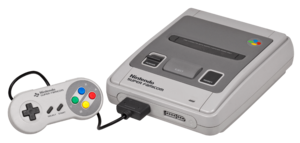| Site News |
|---|
| Warning: This wiki contains spoilers. Read at your own risk! Social media: If you would like, please join our Discord server, and/or follow us on X (Twitter) or Tumblr! |
Super Famicom: Difference between revisions
m (Reverted edits by Yoshi's Woolly World (talk) to last revision by PikaSamus) Tag: Rollback |
|||
| (10 intermediate revisions by 6 users not shown) | |||
| Line 1: | Line 1: | ||
{{Wikipedia}} | {{Wikipedia}} | ||
{{Nwiki}} | |||
[[File:Super Famicom.png|thumb|right|A Super Famicom system, the Japanese version of the Super Nintendo Entertainment System.]] | [[File:Super Famicom.png|thumb|right|A Super Famicom system, the Japanese version of the Super Nintendo Entertainment System.]] | ||
The '''Super | The '''Super Famicom''' (Japanese: {{hl|スーパーファミコン|Sūpā Famikon}} ''Super Famicom'') is a 16-bit video game console created by [[Nintendo]] as its flagship hardware in the [[wikipedia:History of video game consoles (fourth generation)|fourth generation]] of video game systems, and the successor of the [[Family Computer]]. The system was released in Japan in 1990. It was rebranded as the '''Super Nintendo Entertainment System''' overseas, and was released in the United States in 1991, and in Europe and Australia in 1992; it was succeeded in 1996 by the [[wikipedia:Nintendo 64|Nintendo 64]]. During its lifetime in Japan, the Super Famicom was supported by the [[wikipedia:Satellaview|Satellaview]] satellite modem broadcast add-on for the main console, streaming games and accompanying radio content to the console on a broadcasting schedule. | ||
Three games in the {{FES}} were released for the Super Famicom in Japan, in addition to a series of four Satellaview broadcasts collectively known as {{FEBS}}. None of these games were ever released for the Super Nintendo Entertainment System outside of Japan. | Three games in the {{FES}} were released for the Super Famicom in Japan, in addition to a series of four Satellaview broadcasts collectively known as {{FEBS}}. None of these games were ever released for the Super Nintendo Entertainment System outside of Japan. | ||
=={{FES}} games available for the Super | =={{FES}} games available for the Super Famicom== | ||
* {{FE3}} (Japan only) | * {{FE3}} (Japan only) | ||
* {{FE4}} (Japan only) | * {{FE4}} (Japan only) | ||
| Line 16: | Line 17: | ||
<gallery> | <gallery> | ||
File:Super Famicom.png|A Super Famicom system. | File:Super Famicom.png|A Super Famicom system. | ||
File:Satellaview.jpg|A Super Famicom system with the [[Satellaview]] add-on installed. | File:Satellaview.jpg|A Super Famicom system with the [[wikipedia:Satellaview|Satellaview]] add-on installed. | ||
</gallery> | </gallery> | ||
{{refbar}} | {{refbar}} | ||
{{NavConsoles}} | {{NavConsoles}} | ||
Latest revision as of 14:12, 16 January 2023
| This article or section is a short summary of Super Famicom. Wikipedia features a more in-depth article. |
| This article or section is a short summary of Super Famicom. NintendoWiki features a more in-depth article. |
The Super Famicom (Japanese: スーパーファミコン Super Famicom) is a 16-bit video game console created by Nintendo as its flagship hardware in the fourth generation of video game systems, and the successor of the Family Computer. The system was released in Japan in 1990. It was rebranded as the Super Nintendo Entertainment System overseas, and was released in the United States in 1991, and in Europe and Australia in 1992; it was succeeded in 1996 by the Nintendo 64. During its lifetime in Japan, the Super Famicom was supported by the Satellaview satellite modem broadcast add-on for the main console, streaming games and accompanying radio content to the console on a broadcasting schedule.
Three games in the Fire Emblem series were released for the Super Famicom in Japan, in addition to a series of four Satellaview broadcasts collectively known as Fire Emblem: Archanea Saga. None of these games were ever released for the Super Nintendo Entertainment System outside of Japan.
Fire Emblem series games available for the Super Famicom
- Fire Emblem: Mystery of the Emblem (Japan only)
- Fire Emblem: Genealogy of the Holy War (Japan only)
- Fire Emblem: Thracia 776 (Japan only)
Satellaview
- Fire Emblem: Archanea Saga (Japan only)
Gallery
A Super Famicom system with the Satellaview add-on installed.
References
| Consoles of the Fire Emblem series | ||||
|---|---|---|---|---|
|


